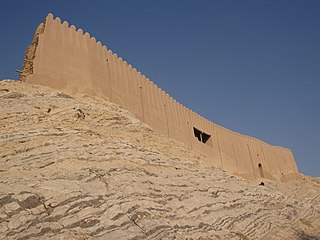Jalinus was a 7th-century Armenian dynast, who was one of the leading figures in Sasanian Iran. He was the commander of the guard over Khosrow II, during the latter's imprisonment. Jalinus was a Sasanian commander during the Arab conquest of Iran.

The kanārang was a unique title in the Sasanian military, given to the commander of the Sasanian Empire's northeasternmost frontier province, Abarshahr. In Byzantine sources, it is rendered as chanaranges and often used, for instance by Procopius, in lieu of the holder's actual name.
Golon Mihran, also known as Mihran Mihrevandak, was a Sasanian spahbed, and also the marzban of Persian Armenia from 572 to 574. Golon was mentioned by Sebeos as an Sasanian commander in Armenia. He was also a member of the House of Mihran.

The Sasanian dynasty was the house that founded the Sasanian Empire of Iran, ruling this empire from 224 to 651 AD. It began with Ardashir I, who named the dynasty in honour of his predecessor, Sasan.
Shahrvaraz Jadhuyih was a Sasanian military officer from the Mihran family. He was related to Shahrbaraz, the Sasanian spahbed and briefly shahanshah. He participated in the battle of Isfahan along with Fadhusfan and another Persian general against the Islamic Arabs. He was, however, defeated and killed during the battle.
Andarzaghar was a 7th-century Sasanian general that fought against the Muslims during the Islamic invasion of Iran. A native of Asoristan, he belonged to a lower rank of land-owning magnates (dehqan) who were centered around the villages and rural subdistricts of the province. He was originally in charge of protecting the borders of Khorasan, but was ordered by the Sasanian king to protect the western frontiers from the Arabs who were plundering Persia. In 633, Andarzaghar, along with Bahman Jadhuyih, with an army composed of Iranians and Christian Arabs, made a counter-attack against the army of Khalid ibn al-Walid at the Walaja, but were defeated. Andarzaghar then fled, and died of thirst in the desert.
Shapur-i Shahrvaraz, also known as Shapur V, was Sasanian king (shah) of Iran briefly in 630.
Mihran Bahram-i Chubin was an Iranian nobleman from the House of Mihran. He was the son of Bahram Chobin, the famous Sasanian spahbed and briefly shahanshah. Mihran, with the aid of Christian Arab tribes, fought against the Muslim Arabs at Ayn al-Tamir. He was however, defeated. What happened to Mihran afterwards is unknown; however, it is known that he had a son named Siyavakhsh, who fell to the Arabs in 651 at Ray.

The Battle of Spahan was fought between the Rashidun Caliphate and the Sasanian Empire in 642. The Arabs were victorious during the battle, where they reportedly killed the Mihran commander Shahrvaraz Jadhuyih. After the battle, the Arabs made peace with Fadhusfan, the governor of the city. According to Abu No'aym, many people were killed or enslaved after the conquest and the settlement pattern of the region changed. Isfahan capitulated by 644 after a few failed revolts and treaties for paying taxes and tributes in exchange for military protection were drawn up.
The Battle of Waj Rudh was fought in 642/643 between the Rashidun Caliphate under Nu'man, and the Sasanian Empire under the Dailamite Muta, the Parthian Farrukhzad and Isfandiyar, and the Armenian Varaztirots. The battle was fought in Waj Rudh, a village in Hamadan. The location was precisely theorized and occurred on a road junction between Hamadan and Qazvin.
Isfandyadh was an Iranian aristocrat from the Ispahbudhan family, who was the ruler of the Sasanian province of Adurbadagan. He was the son of the powerful Sasanian general Farrukhzad, who was the brother of Rostam Farrokhzad and the son of Farrukh Hormizd.

The Battle of Ray was fought between the Sasanians and the Rashidun Caliphate in 651. It was also part of the rivalry between the Ispahbudhan family and the Mihran family.
The Battle of Badghis was fought in 654 between the Karen family and their Hephthalite allies against the Rashidun Caliphate.
Valash, was an Iranian prince from the House of Karen, who later became the ruler of Tabaristan in 665.
Mihran-i Hamadani, known in Arabic sources as Mihran ibn Mihrbundadh, was a Sasanian military officer from the Mihran family. He was the son of a certain Mihrbandad, who is mentioned in some lines in a poem.
Aparviz was an Iranian aristocrat, who served as the marzban of Sakastan in the 7th-century.
Peroz was king of Gogarene and Gardman, ruling from 330 to 361. He was the founder of the Mihranid dynasty, an offshoot of the House of Mihran, one of the seven Parthian clans.
The House of Spandiyadh was one of the seven great houses of the Sasanian Empire. Like the House of Mihran, their seat laid at Ray, which made the German scholar Theodor Nöldeke suggest that they may have been the same family. Like most of the other seven great houses, the House of Spandiyadh was of Parthian origin. The family claimed descent from the legendary Kayanid figure Isfandiyar, who was the son of Vishtaspa, who according to Zoroastrian sources was one of Zoroaster's early followers.
The Asawira were a military unit of the Rashidun and Umayyad Caliphate. The unit consisted of Iranian noblemen who were originally part of the aswaran unit of the Sasanian army. It was disbanded in 703 by al-Hajjaj ibn Yusuf.
Karen was a Parthian prince, who is considered the eponymous founder of the House of Karen, one of the Seven Great Houses of Iran.




